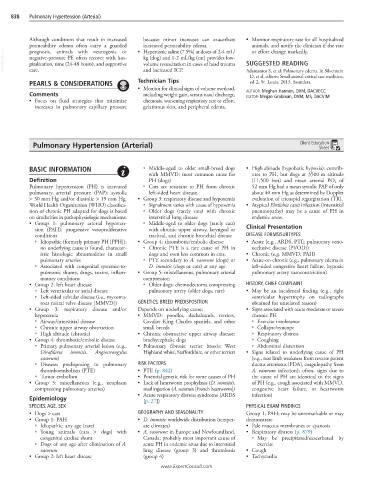Page 1669 - Cote clinical veterinary advisor dogs and cats 4th
P. 1669
838 Pulmonary Hypertension (Arterial)
Although conditions that result in increased because minor increases can exacerbate • Monitor respiratory rate for all hospitalized
increased permeability edema.
permeability edema often carry a guarded • Hypertonic saline (7.5%) at doses of 2-4 mL/ animals, and notify the clinician if the rate
VetBooks.ir negative-pressure PE often recover with hos- kg (dog) and 1-2 mL/kg (cat) provides low- SUGGESTED READING
or effort change markedly.
prognosis, animals with neurogenic or
volume resuscitation in cases of head trauma
pitalization, time (24-48 hours), and supportive
and increased ICP.
care.
Adamantos S, et al: Pulmonary edema. In Silverstein
D, et al, editors: Small animal critical care medicine,
PEARLS & CONSIDERATIONS Technician Tips ed 2, St. Louis, 2013, Saunders.
• Monitor for clinical signs of volume overload,
Comments including weight gain, serous nasal discharge, AUTHOR: Meghan Harmon, DVM, DACVECC
EDITOR: Megan Grobman, DVM, MS, DACVIM
• Focus on fluid strategies that minimize chemosis, worsening respiratory rate or effort,
increases in pulmonary capillary pressure gelatinous skin, and peripheral edema.
Pulmonary Hypertension (Arterial) Client Education
Sheet
BASIC INFORMATION ○ Middle-aged to older small-breed dogs • High altitude (hypobaric hypoxia): contrib-
with MMVD; most common cause for utes to PH, but dogs at 3500 m altitude
Definition PH (dogs) (11,500 feet) and mean arterial PO 2 of
Pulmonary hypertension (PH) is increased ○ Cats are resistant to PH from chronic 52 mm Hg had a mean systolic PAP of only
pulmonary arterial pressure (PAP): systolic left-sided heart disease. about 40 mm Hg as determined by Doppler
> 30 mm Hg and/or diastolic > 19 mm Hg. • Group 3: respiratory disease and hypoxemia evaluation of tricuspid regurgitation (TR).
World Health Organization (WHO) classifica- ○ Signalment varies with cause of hypoxemia • Atypical Ehrlichia canis infection (interstitial
tion of chronic PH adapted for dogs is based ○ Older dogs (rarely cats) with chronic pneumopathy) may be a cause of PH in
on similarities in pathophysiologic mechanisms: interstitial lung disease endemic areas.
• Group 1: pulmonary arterial hyperten- ○ Middle-aged to older dogs (rarely cats) Clinical Presentation
sion (PAH): progressive vasoproliferative with chronic upper airway, laryngeal or
conditions tracheal, and chronic bronchial disease DISEASE FORMS/SUBTYPES
○ Idiopathic (formerly primary PH [PPH]): • Group 4: thrombotic/embolic disease • Acute (e.g., ARDS, PTE, pulmonary veno-
no underlying cause is found, character- ○ Chronic PTE is a rare cause of PH in occlusive disease [PVOD])
istic histologic abnormalities in small dogs and even less common in cats. • Chronic (e.g. MMVD, PAH)
pulmonary arteries ○ PTE secondary to A. vasorum (dogs) or • Acute-on-chronic (e.g., pulmonary edema in
○ Associated with congenital systemic-to- D. immitis (dogs or cats) at any age left-sided congestive heart failure, hypoxic
pulmonic shunts, drugs, toxins, inflam- • Group 5: miscellaneous, pulmonary arterial pulmonary artery vasoconstriction)
matory conditions compression
• Group 2: left heart disease ○ Older dogs: chemodectoma compressing HISTORY, CHIEF COMPLAINT
○ Left ventricular or atrial disease pulmonary artery (older dogs, rare) • May be an incidental finding (e.g., right
○ Left-sided valvular disease (i.e., myxoma- ventricular hypertrophy on radiographs
tous mitral valve disease [MMVD]) GENETICS, BREED PREDISPOSITION obtained for unrelated reason)
• Group 3: respiratory disease and/or Depends on underlying cause: • Signs associated with acute moderate or severe
hypoxemia • MMVD: poodles, dachshunds, terriers, chronic PH
○ Airway/interstitial disease Cavalier King Charles spaniels, and other ○ Exercise intolerance
○ Chronic upper airway obstruction small breeds ○ Collapse/syncope
○ High altitude (chronic) • Chronic obstructive upper airway disease: ○ Respiratory distress
• Group 4: thrombotic/embolic disease brachycephalic dogs ○ Coughing
○ Primary pulmonary arterial lesion (e.g., • Pulmonary fibrosis: terrier breeds; West ○ Abdominal distention
Dirofilaria immitis, Angiostrongylus Highland white, Staffordshire, or other terriers • Signs related to underlying cause of PH
vasorum) (e.g., rear limb weakness from reverse patent
○ Diseases predisposing to pulmonary RISK FACTORS ductus arteriosus [PDA], coagulopathy from
thromboembolism (PTE) • PTE (p. 842) A. vasorum infection); often, signs due to
○ Tumor embolism • Potential genetic risk for some causes of PH the cause of PH are identical to the signs
• Group 5: miscellaneous (e.g., neoplasm • Lack of heartworm prophylaxis (D. immitis), of PH (e.g., cough associated with MMVD,
compressing pulmonary arteries) snail ingestion (A. vasorum [French heartworm]) congestive heart failure, or heartworm
• Acute respiratory distress syndrome (ARDS infection)
Epidemiology [p. 27])
SPECIES, AGE, SEX PHYSICAL EXAM FINDINGS
• Dogs > cats GEOGRAPHY AND SEASONALITY Group 1: PAH; may be unremarkable or may
• Group 1: PAH • D. immitis: worldwide distribution (temper- demonstrate
○ Idiopathic: any age (rare) ate climates) • Pale mucous membranes or cyanosis
○ Young animals (cats > dogs) with • A. vasorum: in Europe and Newfoundland, • Respiratory distress (p. 879)
congenital cardiac shunt Canada; probably most important cause of ○ May be precipitated/exacerbated by
○ Dogs of any age after elimination of A. acute PH in endemic areas due to interstitial exercise
vasorum lung disease (group 3) and thrombosis • Cough
• Group 2: left heart disease (group 4) • Tachycardia
www.ExpertConsult.com

